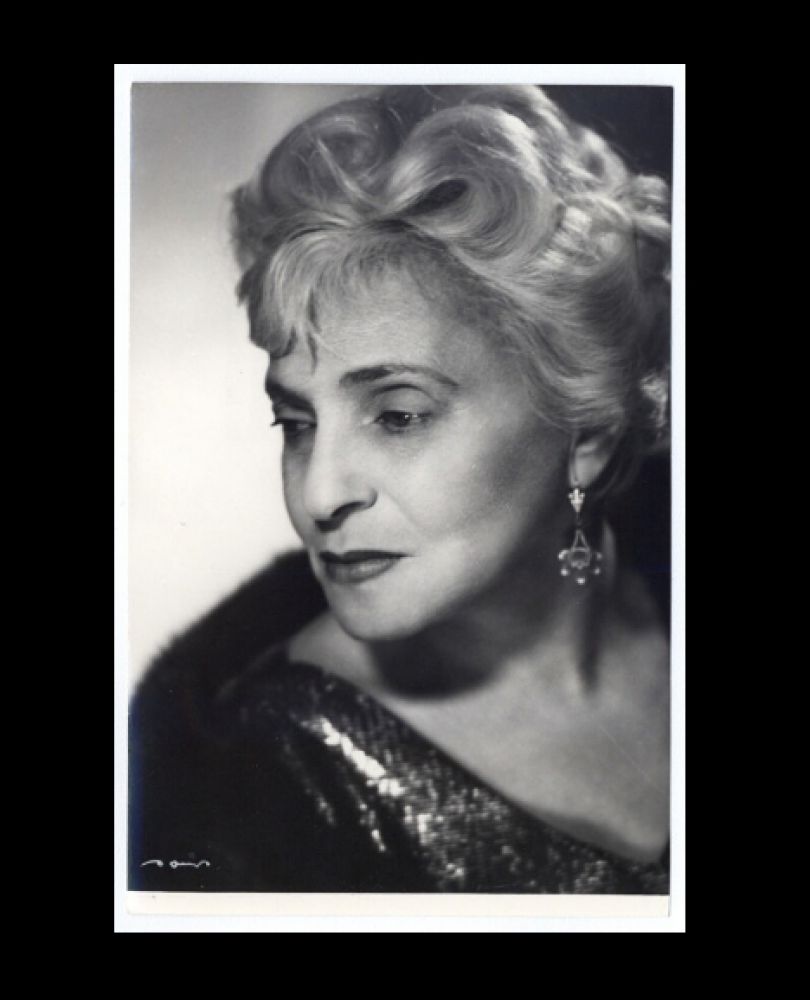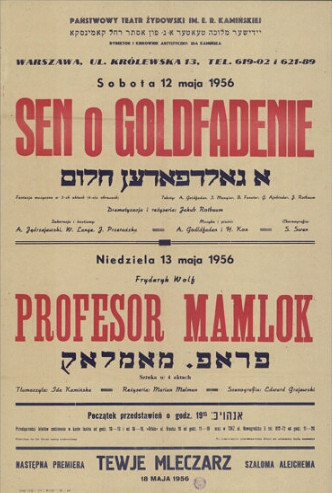- News
- Events
- Oneg Shabbat
- Collections
- Research
- Exhibitions
- Education
- Publishing Department
- Genealogy
- About the Institute
- Bookstore


She had been living in the United States only for 12 years, after emigrating from Poland in the Summer of 1968. Being nearly 70 years old, she had to reorganize her life – and her theatre – yet again.
Ida Kamińska was born in Odessa, in the theatre hotel. Her parents were there on guest appearances. Ida’s father, Izaak Kamiński, was a director, actor and theatre entrepreneur, and her mother, famous Ester Rachel Kamińska, was known as 'Jewish Eleonora Duse'.
Theatre ran in Ida’s blood. Her talent was revelaed quickly, when as a small child she made a stage debut alongside her mother and received a lot of praise. Still, she considered the role of Isaac in Abraham Goldfaden’s operetta Akeydos Yitschok (The Sacrifice of Isaac) at the age of 16. Soon, theatre became such an important part of her life that she gave up school and decided to continue education on her own and to contribute to the perfection of the Jewish theatre. In her parents’ troupe, she worked as an actress, but also as a stage manager, translator, director and scriptwriter.
In 1918, she married Zygmunt Turkow, an actor and director as talented as herself. They both shared an ambition to make Jewish theatre equal with contemporary European theatres. They established WIKT - Warszewer Jidiszer Kunst Teater (Jewish Art Theater of Warsaw), where they staged plays by Jewish classics, such as Solomon Ettinger, Mendel Mocher Sforim or Shalom Asch in a modern, innovative style – but also European dramas by Moliere, Gogol or Victor Hugo.
When the WIKT troupe and the marriage with Turkow collapsed in the early 1930s, Kamińska launched her own troupe, with whom she travelled to Vilnius to celebrate the 20th anniversary of her stage debut. In 1936, she married actor Meir Melman.
Despite anti-Semitic moods being on the rise in Poland, Kamińska continued her successful career. She was translating, adapting and staging European and Jewish dramas. In search for roles for herself, she translated Zapolska’s Miss Maliczewska, Bouisson’s Madame X, J. Tepa’s Fräulein Doktor. She also translated to Yiddish The Jazz Singer, a very popular American musical, where she also played the leading role of a cantor’s son who makes a career as a jazz singer in New York, performing in blackface. She also staged Max Baumann’s Glikl fun Hameln in her own translation and with herself in the main role. She always emphasised that no theatrical season would be complete without the classic of Jewish theatre, Jacob Gordin’s Mirele Efros.
In October 1939, she escaped to Lviv together with her husband, her daughter Rut Kamińska and friends. There, she was nominated to the position of the director of the State Jewish Theatre by the Soviet authorities, but in 1941, Kamińska and Melman escaped further away into Central Asia, to Kyrgyzstan, where she also established a theatre troupe consisting of Jewish actors – defectors from Europe.
They returned to Poland in 1946. Ida Kamińska again continued to do what she did best – she opened a theatre, this time in Łódź. She encouraged famous director Jakub Rotbaum to return from the United States and help her rebuild Jewish theatre. In 1950, she became the head of the new State Jewish Theatre in Warsaw.
Developing theatre in postwar Poland was a very difficult enterprise. Her group comprised several actors from the pre-World War II era, such as Chewel Buzgan, Rywa Szyler-Buzgan and Michał Szwejlich, as well as Ida Kamińska’s family members: husband Meir Melman and daughter Rut Kamińska, but also other people. According to Henryk Grynberg, a member of her group, Kamińska knew how to cast us and to set us on stage in the way that we looked like real actors. But only up to here! You must not be exposed! [1]. As the manager of the State Jewish Theatre in Communist Poland, she had to maintain good relationships with the authorities, so she occassionally included Socialist-themed plays into the program. She struggled with an increasingly smaller number of people speaking Yiddish in the audience. Still, she kep receiving positive reviews, for example for the first Polish adaptation of Bertolt Brecht’s Mother Courage. Jan Kott wrote: Ida Kamińska is one of the best dramatic actresses. But this time, she didn’t have to learn the role. She was and she is Jewish Mother Courage. [2]

Her most famous role was a part in Ján Kadár’s The Shop on the Main Street, a Czechoslovak film from 1967. She was nominated to the Oscar award for her role, as the first actress from behind the Iron Curtain. The film received the Academy Award for the best foreign film. This success was widely commented in Poland, and Kamińska was always called 'a Polish actress' in this context.
In her memoir, My life, my theater (1973), Ida Kamińska recalled that in 1968, during an afternoon nap, she had a dream about Hitler and crowds parading in front of him with right arms stretched and shouting:
Sieg Heil! Sieg Heil! Kamińska woke up scared, but the shouting didn’t stop. She ran to the television and saw Gomułka on the screen. The crowds were cheering: Wiesław! Wiesław! Soon afterwards, in the Summer of 1968, Kamińska with her husband, daughter and son-in-law were already in Vienna, on their way to New York.
The State Jewish Theatre had a successful US tour in 1967 and Kamińska was certain that she can expect a reliable audience. Unfortunately, the reality turned out to be different. Her acting was too traditional, repertoire was exotic, the audience didn’t speak Yiddish. Her plan to launch a Jewish theatre in the United States failed. She played sporadically, her letters and memoirs reveal disappointment. In 1975, during her visit to Poland, she said a famous phrase from the stage of the Jewish Theatre: The Jews of Warsaw! I don’t know who did a better thing: was it me who left, our you who stayed?
Ida Kamińska’s grave is located at the New York Mount Hebron cemetery, among many other famous artists of American Yiddish theatre.
Footnotes:
[1] Henryk Grynberg, Życie osobiste, Oficyna Wydawnicza „Pokolenie“, Warszawa 1989, ss. 35–36.
[2] Jan Kott, Mutter Courage [w:] tegoż, Pisma Wybrane, t. 3, Krąg, Warszawa 1991, s. 155.